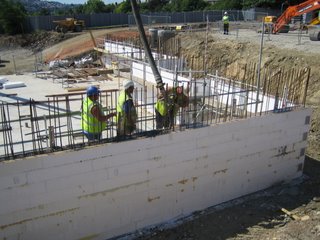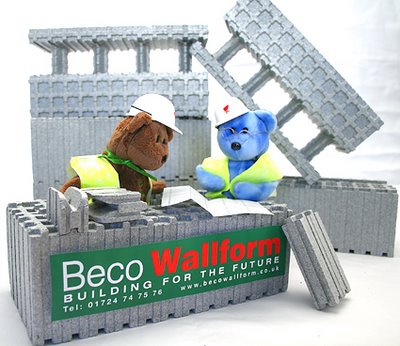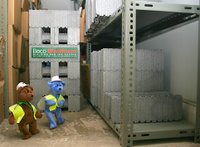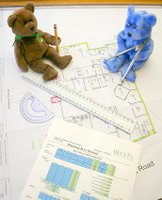MONSTER MACHINES IN OUR PARK!What's all this then? Well, we probably haven't said before but the new school is going to have 'ground source heating'. What on earth is that you might ask (as we did)?Well, it is heating from the earth. Yeah, come on who are you kidding you might say!
A little way down the temperature of the ground is always about 12 degrees celsius because it has stored the heat from the sun, we can use this to heat the school. If you're really clever like our engineer you can make it cool the school in summer becasue you can take the heat from the school and put it back in the ground.
 'Ground source heat pumps (GSHP) transfer heat from the ground into a building to provide space heating and, in some cases, to pre-heat domestic hot water. ' So says the Energy Saving Trust. You can go to their website (follow this link).
'Ground source heat pumps (GSHP) transfer heat from the ground into a building to provide space heating and, in some cases, to pre-heat domestic hot water. ' So says the Energy Saving Trust. You can go to their website (follow this link).
http//www.est.org.uk/myhome/generating/types/groundsource/ if you want to know more.
You can lay pipes in trenches, but our site is too small and if we did that in the park it would mess up the whole park and that wouldn't be fair on everyone else. It can also work if you drill long holes deep into the ground and put pipes into those. The school will need quite a lot (30 or 40 maybe, nobody knows yet) and our site is still too small.so we have asked the people who own and look after the park if we can have our heat from there and they have said OK.
 So the machine (drilling rig) in the picture is drilling a test hole. It will be at least 100m deep!!! WOW. We couldn't even run that far! It took nearly 2 days to drill. Can you see us on the drilling rig? It was very messy as the ground is drilled there is lots of water and stuff that comes out of the hole.
So the machine (drilling rig) in the picture is drilling a test hole. It will be at least 100m deep!!! WOW. We couldn't even run that far! It took nearly 2 days to drill. Can you see us on the drilling rig? It was very messy as the ground is drilled there is lots of water and stuff that comes out of the hole.

When it was finished all we could see were these two pipes!
 There is a special van in the park at the moment. It is connected to the pipes and is testing to see how much heat there is in the ground. It needs to stay there for 4 days to do a proper job. It will be gone before the festival as long as it is left alone to get on with the test.
There is a special van in the park at the moment. It is connected to the pipes and is testing to see how much heat there is in the ground. It needs to stay there for 4 days to do a proper job. It will be gone before the festival as long as it is left alone to get on with the test.














